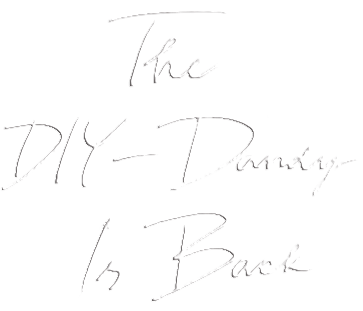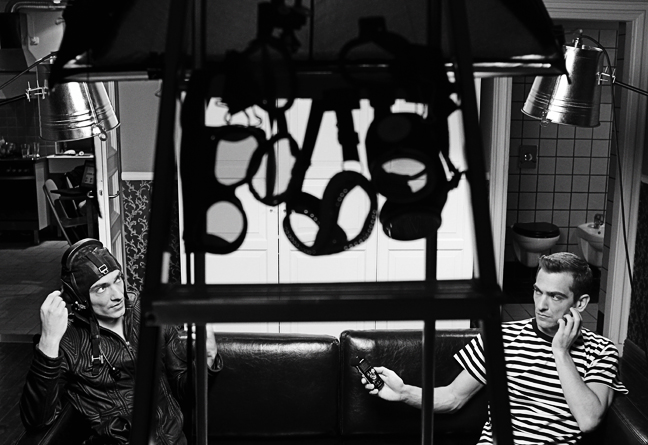


Text and Photographs by Laszlo Fogarasi Jr.

You have been off the radar for quite some time. Is this your regular schedule? They say all good dandies must go into exile…
It wasn’t planned, but somehow I always end up like this. I could also say that I work like the good old Soviet Union, with five-
years plans.
I see. As far as I remember Splendid Isolation was released in 2005. So isn’t it six years already?
This is what makes it an authentic five-year plan. The work that goes according to plan, finishes on time without any kind of agony, cannot be considered a real creative process. Deadlines are overly important things and there is a big need for them, but to have the freedom of crossing a deadline, if the material needs it, is maybe even more important. By the way, the tour for the previous album was closed in 2007 September, so basically the actual work took a good three years. From my three albums, I spent the most time on this new one. But it could be due to fact as well that I’m trying to do more and more things myself from record to record. Lots of today’s music or film projects are rather similar to a production line, which delivers products that are perfect in every detail, but still give a muddled and impersonal impression in total. They wear the fingerprints of too many people on their surface, and details can often work against each other. I prefer to walk around the project, and develop as many details as possible by myself. It is not the goal to create a product that is perfect in its every particle, but to create a final result that is as personal as possible. Next to the creative aspects of composing, the technical side is at least as much exciting to me, so I spend a lot of time with experimenting and getting to know new territories. This is why mixing the album or making the cover myself are very important achievements to me. I admit this is not the fastest way of working, but at least this way it remains personal.
And how can you stay objective?
I cannot. I don’t even intend to. I believe the more subjective flavor a story has got, the more interesting it is. In everyday’s concentration regular sport is a big help, like swimming or biking…anything but not on the computer screen. Or cooking. After the keyboard it is very calming to paddle with vegetables and fruits. Chop them and smell them while the food is being done. But there are moments when such mooning away doesn’t help, for instance when you get fed up with a whole work-phase. Then it is the best to let go the task and do something else. Doing something completely different is even better, like collaborating with someone or existing in a community for a while.
Did you have a lot of those collaborations recently?
Well, I’m rejecting more than I accept, but I did have some. It used to go quite lucky, because inspiring requests always came whenever they were needed. For instance, around the summer of 2008 I was really stuck with the album, and I tried to get inspired by catching up with Peter Greenaway’s lesser-known films. I was just about to admit that the watching-films method that worked out so well for Splendid Isolation was not working anymore. And then a few weeks later came the unbelievable opportunity to work together with Greenaway on a special VJ versus DJ show that was presented in February 2009 in Berlin, and it was a truly memorable experience. I also threw a few exclusive DJ sets over the years, where I smuggled the new songs that I was working on into the set, so I was able to test them on a real audience. I was a surprise guest DJ for the three launch parties for The Room, one show I did in Amsterdam, and once I played in New York at the Brooklyn Museum. After the show I stayed for a few months in New York in the fall of 2009, which was very inspiring too. The city definitely left its mark on the record. Just like I was making mixes for several fashion shows by USE unused, and once for Je Suis Belle. Oh, and last winter I did stage music for Pedro Calderón’s Life is a Dream, directed by Dani Kovács at the Kamra Theatre in Budapest. But all in all these projects didn’t take that much time, the highest priority was writing the new album, Passive Control.
Passive Control. Another typical contradictory title. This is getting predictable.
I’m attracted to oxymorons, that’s true. I already knew the title about six years ago, so even before my second album was released, I already knew the title of the third. It’s relaxing to live and work with a concept like this for years. A good title gives a frame to the project, it defines its borders, what can or cannot fit in.
Where is it coming from and what does it mean to you?
My titles are always kaleidoscopic, they have multilayered meanings, so don`t expect an exact answer on this. But in that period when I found it out, I remember that I started to look at life a bit differently. I began to be able to let go, accept things the way they are. Too much control, or at least the illusion of it, is the typical mistake of mankind. However, we are able to control our lives and the environment just as much as a surfer can control the ocean’s waves. So basically, not at all. The wave is the boss at all times and decides where to go. The only thing that is up to the surfer’s talent is how long he can stay on the board. I was thinking about stuff like that back then. Passive Control could also describe the typical mindset that social networking sites create. You sign up, put yourself in the little showroom, and then you WAIT. Like fishing. Sometimes you throw in some bait, but secretly you hope that one day something unexpected will pull the other end of the line…
And what are your experiences, did you manage to catch anything?
The funny thing is that the experiment worked. I couldn’t get to like hanging on these websites as an activity. The only truly fun and honest social network site I found is E-bay, that is my favourite. Facebook was a disappointment, it is the magnet for all the boring rumors and shallow smalltalk that I can’t stand to listen to in real life either. But a few years before that, the Myspace boom was quite exciting. For a short moment of time it felt like walls breaking down between artists and that it was a start for a closer communication. By today there is almost nothing left of this phenomenon, but back then several unknown singers wrote me from all over the world. First I rejected the whole idea of finding a contributor this way, but later I caught myself playing with the thought. It started to sound exciting for me to find an unknown singer, who I can involve much more in the work, and even form to the role, instead of a half famous one who is only interested in putting his or her trademark on as many products as possible. So I started to observe and collect possible singers, and the most potential candidate requested my friendship around the end of 2008. She only wrote: “Let’s make a project together.” Although it sounded a little bit too direct, In the end it fit the concept of the record. And last but not least she had the voice that I was looking for. She was Charlotte Brandi, a twentyfour-year-old German girl from Cologne.
Did the actual work happen through internet as well?
No, that was out of question from the very beginning. I insisted on the real, old-fashioned way of working together, when both parties stay in the same physical space. We e-mailed at first, and then I traveled to Cologne to meet her in person in the spring of 2009. The timing of the trip made it possible to see her little live-show as well. But the album recordings were made in my Budapest studio, in around twenty days. The twenty days were divided into four sessions, two of them we had in the summer of 2009, and another two in the beginning of 2010. The rule was that she only got to see the songs in Budapest, and she didn’t receive any material beforehand, so she was unable to prepare. I was thinking that the polished and niggling music would give an exciting contrast to a spontaneous human voice that’s almost accidental in some places. In certain cases I did no more than record a few takes of improvisation, the very first spikes. Then later I figured out the final vocal track with tons of cuts and placing. I adore handling newly recorded material as samples. Of course, not every song was made like this; there are more traditional ones among them, of course. But those lines were also written on the spot in a relatively short time. By the way, lyrics generally were less important to me on this album. But to use words that she can emotionally grab onto were much more important in terms of the final result.
How come that you switched to a female voice? The previous album had almost exclusively male voices.
Exactly. Back then I really covered the subject of “what the poor boy feels.” It was time for a female sequel.
So this means the albums are connected?
Actually, the three albums can be handled as a loose trilogy. It’s perfectly possible to listen to the three of them in a row, if someone has the time. For instance, the previous album closed with the voice of Edward Ka-Spel and he’s speaking again from the very first moment of Passive Control. This track is exceptionally dear to my heart and has the most important lyrics on the album. The story goes back to an old Legendary Pink Dots song that I wanted to remix. I bugged Edward several times to send me the vocal track for that song, which he promised several times. Then once around 2008 he wrote that they checked for the vocal, but unfortunately they didn’t store their old tracks in multichannel format. But he offered to re-record it for me, if I wanted to. Of course, I said okay. Although the new recording had only a few verses that were similar to the old one, it instantly hit me. I wanted to make some angry dance track out of that old version, but this new interpretation turned to be the introduction of the album that I named Sustainable Development.
Sustainable Development? Isn’t that a scientific term?
Well, it’s basically science fiction already. True pre-millennium Utopia. Back then economic, environmentalist and sociological studies were full of this nice and ambitious theory; they strongly believed in its feasibility. The only thing that can be said about it today is… LOL. Later, they quietly corrected the term to the much more modest sustainable growth, as if nobody would have ever mentioned development. Though I guess the growth theory won’t be true for too long either, as the forever-growing magic ball. It only exists in fairytales. Not to mention that it explodes at the end of the story.
What inspired you visually?
One of my very favorite subjects is how they imagined today’s world in the past, which was the future for them. It is funny to live in the “future” and to compare how much it didn’t end up as they imagined. William Gibson’s short story The Gernsback Continuum is also about this, I really love that piece and since I was fifteen I read it several times. The world of Jean Gireaud Moebius and the revolutionary French comic magazine Métal Hurlant was an important inspiration, too. Also the amazing Russian science fiction film, Kin Dza Dza, or the Hungarian cult film, Meteo.
What’s happening with the album release process and what are you working on now?
The musical material’s totally done and only the cover’s left. The purpose of the cover portraits is to show, with relatively simple tools, what inner and outer state I was in when I made the album. This simple concept turns out to be interesting by the march of time as more and more snapshots are being made. And one day the whole chap will be browsable from child to old man. The release of the new album will be probably at the end of May, beginning of June. Unfortunately, I can’t say an exact date, as the arrangements with the record company are still ongoing. With this album I finally fulfill my contract with the German record company, and I can’t wait to be a free man. The funny thing is that by that time physical data carriers will most likely disappear as well.
Fulfilled contract, finished trilogy… what’s next?
I don’t know exactly yet. But one thing is for sure: that this album closes a more than ten-year-long chapter. Things rolled over a bit, one circle was being made. Interesting to experience that the giant recycling fashion harvester has reached the world of the 1990s. The music and the visual world that once I already witnessed in original. I was waiting for this wave years ago, as the 1980s were never close to me. But now that it is here, it interests me far less than I thought. I find myself being interested in actual trends less and less. But I can see my own path much more clearly. I have several record ideas in my head, I only need to decide which one to realize first. But before that I’d like to make several videos for Passive Control, as many as possible. I hope we can start that before the summer already, I can’t wait. And the closest close future, actually the present itself is a stage-music for the Katona József Theatre in Budapest. Although I’m right in the middle of the release, I simply couldn’t say no to the request of Tamás Ascher, who I wanted to work with a long time ago. The piece is called Dilettanti and is based on Flaubert’s unfinished novel Bouvard and Pécuchet.